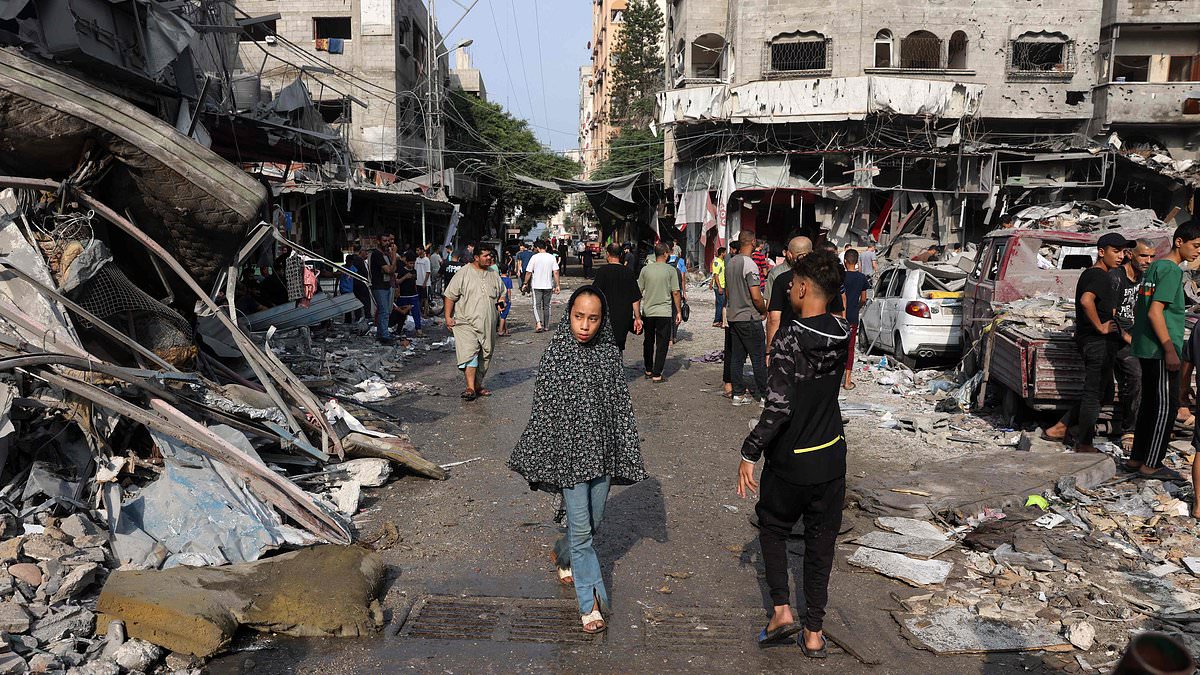First the lights went out, then the mobile phone signal and internet went down. And then the bombs fell, relentlessly, for hours.
Cut off from the outside world, Gaza endured one of the worst nights of bombardment in its troubled history, with its inhabitants left in a state of ‘panic, fear and chaos’ as Israel swore bloody revenge on Hamas terrorists.
Amid a near-total communications blackout, ambulances were said to be unable to reach the dead and injured. Paramedics drove towards explosions in the hope of reaching casualties.
Israel’s target was Hamas terrorists who slaughtered 1,400 Israelis three weeks ago in a barbaric attack.
But ordinary Palestinians have also paid a heavy toll. Shocking images emerged yesterday of the Palestinian territory reduced in many parts to nothing but rubble in Israel’s aerial blitz.
Palestinian civilians have paid a heavy price in the bloodiest conflict between Israel and Hamas in decades
Shocking images emerged yesterday of the Palestinian territory reduced in many parts to nothing but rubble in Israel’s aerial blitz
Infrastructure in the Strip was destroyed by IDF missiles over the weekend
Israel did begin to allow humanitarian aid convoys to access southern Gaza while pounding the north with missiles, artillery and tank shells.
Last night, the Israeli military issued further warnings for Gazans to get out of harm’s way as the enclave braced for another pummelling.
Desperate UN calls for a ceasefire were ignored as the death toll shot past 7,700, including more than 3,000 children, according to the Hamas-run health ministry.
With no communications, Gazans resorted to walking or stumbling over the debris to reach their relatives and friends.
‘It is a state of panic, fear and chaos; very chaotic scenes in the street. People don’t know what to do in these circumstances,’ said BBC correspondent Rushdi Abualouf, speaking from the southern city of Khan Younis on a satellite phone.
A Palestinian carries a wounded man following an Israeli airstrike on northern Gaza
Smoke rises over Gaza, as seen from Israel’s border with Gaza on Saturday
Fire and smoke rise following an Israeli airstrike in the Gaza Strip, as seen from southern Israel
Israeli Iron Dome air defense system fires to intercept a rocket fired from the Gaza Strip
‘The bombs were everywhere, the building was shaking,’ said Hind al-Khudary, a journalist in central Gaza. ‘We can’t reach anyone or contact anyone. I do not know where my family is.’
The UN agency for Palestinian refugees, which runs shelters and schools for nearly half of all displaced Gaza residents, said it had lost contact with most of its staff and that co-ordinating aid efforts was now ‘extremely challenging’.
Tedros Adhanom, head of the World Health Organization, said the blackout had made it impossible for ambulances to reach the injured.
Melanie Ward, chief executive of charity Medical Aid for Palestinians, told BBC Radio 4’s Today programme that she had not been able to reach humanitarian workers operating within Gaza since Friday afternoon.
She said: ‘We are desperately worried for all of our colleagues.’ Hamas health ministry spokesman Ashraf al-Qidra told reporters the disruption of communications had ‘totally paralysed’ the health network.
Israel’s Prime Minister Benjamin Netanyahu vowed to ‘completely eliminate’ Hamas on Saturday night
Some civilians were using their bare hands to pull injured people from the rubble and loading them into personal cars or donkey carts to rush them to the hospital.’
Israel said its strikes target Hamas fighters and infrastructure, and that the militants operate from among civilians, putting them in danger. Across Gaza, terrified civilians were huddling in homes and shelters with food and water supplies running out.
More than 1.4 million Gazans have fled their homes, nearly half crowding into UN schools and shelters.
Last night, Israel Defence Forces (IDF) spokesperson Rear Admiral Daniel Hagari said: ‘On the humanitarian aspect: to all Gaza residents who have moved on south of the Gaza stream we are going to increase our humanitarian efforts.’
UN trucks carrying staple food did arrive in Gaza. But Cindy McCain, executive director of the World Food Programme, said she was ‘extremely worried’ about aid workers and civilians in Gaza. ‘We are at a tipping point. Humanity must prevail,’ she warned.
UN Secretary-General Antonio Guterres wrote on X (formerly Twitter): ‘I repeat my call for a humanitarian ceasefire in the Middle East, the unconditional release of all hostages, and the delivery of life-saving supplies at the scale needed.
Earlier, Mr Guterres warned that Gaza faced ‘an unprecedented avalanche of human suffering’ because of lack of food, water and power during Israeli bombing in response to the Hamas attack.
